Little Boat, Big Ocean
This project is deeply personal; a collection of the values, feelings, and actions that make me. It is my hope that readers might enjoy the story and feel something for the spaces that represent them as individuals. A deep and heartfelt thank you goes out to the many people, places, and inspirations that helped me along the way.

The ocean has always been there for me. When I had nothing, it gave me work. When I didn’t feel like I belonged, it gave me a home. When I couldn’t stand my own thoughts, it gave me solace. But in return, what had I given it?
I wanted to show that, with enough passion and care, you could do something worthwhile, even with limited resources. I wanted to show this to others, but I also wanted to show this to myself. I know boats and how to make strange connections beyond most other things in my life, and I decided to combine these skills with my affinity for taking long adventures in remote locations.
Enter the Race to Alaska (R2AK): a 750-mile, unsupported, human-powered race from Port Townsend, Washington to Ketchikan, Alaska. A semi-ridiculous event and my testing grounds for finding deeper meaning in the things I already do and love. Using the publicity afforded by the race along with the skills, connections, and privilege I already had, it was time to try something different.
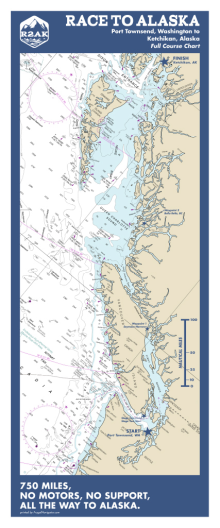
From my time serving as captain and crew on various boats, I have come to understand what makes a good team; a collection of individuals with very different viewpoints who feel comfortable sharing their opinions and perspectives. In this way, a team becomes more than the sum of its individuals. After pestering a close friend for nearly a year, I had my partner in this adventure. A friend from childhood, Pax shared my love of the ocean but not my penchant for high-risk situations, making him a perfect voice of reason for the trip.
We both had backgrounds in commercial fishing and had come to see marine protected areas (MPAs) and other forms of marine spatial planning as one of the most effective tools for bringing together a diverse set of stakeholders in a changing world. Knowing that many organizations shared this viewpoint, we contacted various non-profits local to the Inside Passage and British Columbia coast. Eventually, we partnered with Pacific Wild, a non-profit focused on advocacy and Indigenous-led stewardship in the Great Bear Rainforest and Sea.
Through the wooden boat community, I found a free, 16-foot Swampscott dory rotting in a field down on the Oregon-Washington border. I spent many months restoring and modifying it for the race by using a collection of castoffs from other boats on which I had worked, along with donated and repurposed materials to reduce the ecological impact and financial cost of the trip. Through an amazing twist of fate, I befriended the individual who had originally designed and hand sewn the sails for the dory back in 1976: Emiliano Marino, or “Pine Tar Pete”. Through Emiliano, I also met David Jackson, the boat’s original builder and owner of Freyja Boatworks, as well as Brian Toss, the rigger who originally made and designed the spars and rig of the little dory.
Emiliano became a main sponsor and modified a donated set of sails to make a bigger, more durable mainsail and jib. He and many others helped me in more ways than one as the project progressed. Besides kindly providing me with expertise, labor, and materials, they provided a sounding board for my own journey towards being able to talk about myself and my passions before a larger audience.
Throughout this project, Pax and I struggled with whether this adventure was the most efficient way to advocate for MPAs and Pacific Wild. Were we simply another set of privileged adventurers pursuing our own ends under the guise of doing what is right? Working through this and ensuring that our intentions stayed true was an intense exercise in reflexivity, particularly because the project was such a part of myself. This made it very hard to separate actions from intentions. We decided to take an advocacy-forward stance whenever we spoke about what we were doing. This meant having a clear mission and set of deliverables: money donated to Pacific Wild and presentations focused on inspiration and advocacy for MPAs in the region.
“Were we simply another set of privileged adventurers pursuing our own ends under the guise of doing what is right?”
In the months before the race, I traveled around to classrooms, wooden boat festivals, and other events. I brought the boat and outreach materials from Pacific Wild to tell the story of the trip and talk about the importance of MPAs, Indigenous-led stewardship, and marine planning, all the while emphasizing the work done by Pacific Wild and Coastal First Nations. By using the adventure as an introduction to these topics we were able to reach a broad audience, starting conversations based on a common interest but often with people of very different worldviews.
As always there are complications. A month and a half before the race, disaster struck: a Subaru pulled an abrupt U-turn in a parking lot, entering my lane without a second thought. I will never forget the rush of dread as I felt time screech to a halt like the locked brakes of my truck with the little dory trailing obliviously behind. The centerboard—a fin that drops down while sailing to help the boat go upwind—split down the middle as a result of the impact. My left shoulder dislocated as the force from the crash traveled up through the steering column and into my arm. Despite this, I had given so much of myself to the project at that point that I refused to give up. Pax, my crew for the trip, leapt into action to come help me, quitting his job in Utah he moved onto my couch full time. The next month and a half involved a lot of fiberglass and physical therapy but not much sleep.
As a result of this crash and ill-advised refusal to give up, many of the partnerships and communications projects I had worked so hard to set up were not fully realized. Instead of focusing on producing images and other digital content to tell compelling, identifiable human stories, we spent our time frantically getting the boat and ourselves ready. This took a toll on me both physically and mentally as the goals I had created for myself began slipping further and further from my grasp.

Most of the time, things don’t go the way you expect them. After a rocky first day, we somehow managed a hectic 40-mile crossing of the Strait of Juan de Fuca at the mercy of 30-knot winds against a full spring ebb tide. Despite capsizing just outside the mouth of Victoria Harbor, we finished the proving grounds of the race with 15 minutes to spare. This meant we were “got” to race the next 700+ miles north to Alaska. Hurray!

Traveling through the unceded Coast Salish, Kwakwaka’ wakw, Wuikinuxv, Nuxalk, and Heiltsuk territories in a 16-foot, open, leaky boat, we bailed our way slowly up the coast. Long ago left behind by the fleet of expensive, fast, and relatively comfortable race boats, we focused on the intersection of wild beauty and the commercially extractive enterprises that rely upon the same wild. We grappled with concepts of self, misguided masculinity, privilege, and the paradox of a society whose declared values do not necessarily align with its actions; such emotions are felt deeply when you spend a month only inches from the ocean that makes it all possible.
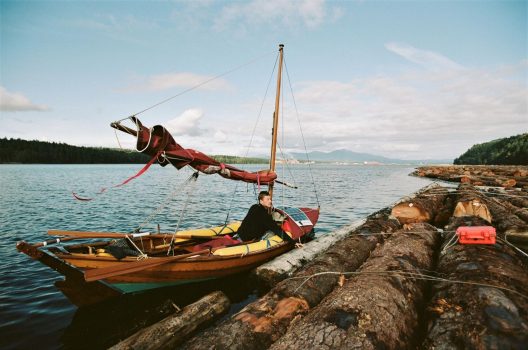



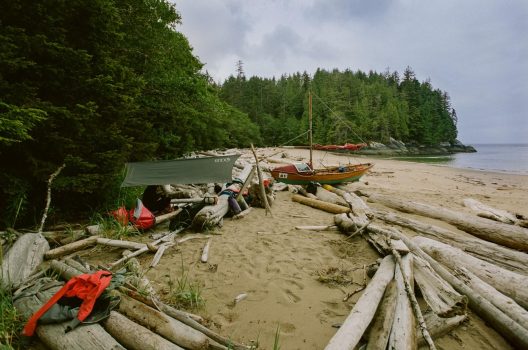
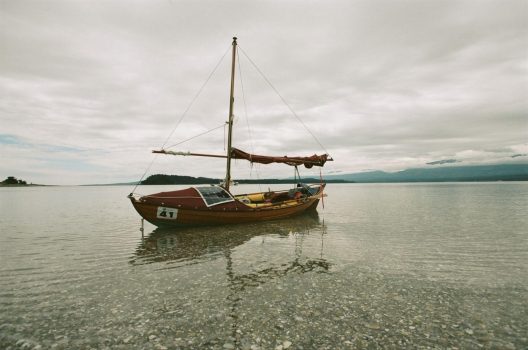
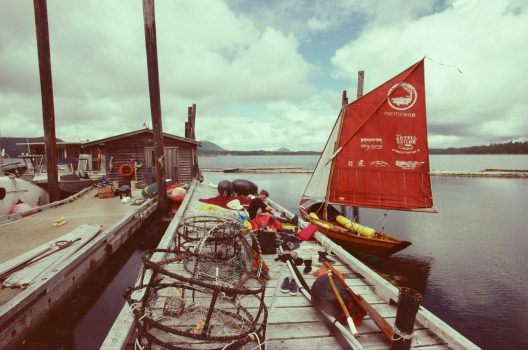
Even though things didn’t go quite according to plan we did make it some 450 miles to Bella Bella. We were also still able to raise just over $4000 for conservation in the area. For a brief moment, we were even semi-famous after our photo finish in Victoria and subsequent shout-out on Canadian Public Radio. Most importantly, we brought our own weird little message of hope and perseverance to several thousand people via the publicity of R2AK and a series of public speaking events.
Joining the 2019 Race to Alaska was a huge step out of my comfort zone, but not in the ways one might think. I’m familiar with navigating new and dynamic waters while living out of a small space without a proper bed or functioning toilet. I’m much less familiar with working with people, being vulnerable, and telling my story. Throughout this project, I often lacked the technical and cultural knowledge to back up many of the statements I was making about MPAs and Indigenous stewardship, I lacked the practice of communicating my thoughts to others, and I lacked the words to describe how I felt.
The experiences provided by this project opened my eyes to the possibilities of storytelling and its capacity to foster connections between people of different backgrounds. It also pushed me to acknowledge my own shortcomings; despite my passion, I had little to no mentorship and a limited community with which to discuss my ideas and learn from in turn. Our methods were obviously skewed towards a specific community and our message of “just getting out there and doing something” might even be alienating to some groups.
These realizations pushed me to seek community and mentorship. In my search for community, I applied to the School of Marine and Environmental Affairs (SMEA) graduate program after a long time away from academia. In SMEA, I hope to reacquaint myself with the specialized language and progressive thinking of the academic community so that I might marry it with my own practical experiences and passion in the hopes of creating more inclusive, reconciliatory narratives that bring new communities into participatory conservation.
Prior to this trip, I often kept secret the things I found meaningful. I had become accustomed to ignoring many of the feelings that gave me the greatest joys in life: sharing nature with diverse audiences, ensuring that the magical web of life that gave rise to the beauty I loved was there for others, and feeling the purpose of just existing. Sometimes I still hide from these feelings, but since this experience, I’ve realized that I have and always will feel very deeply. This can be both my greatest strength or greatest downfall if I give into doubt and despair, both of which fuel apathy.
For many years, I have believed that the greatest threat facing our oceans is our collective apathy to their ongoing destruction. You don’t have to attempt to row to Alaska in a boat you pulled from the bushes to come to this realization. I believe then and now that when you realize that all you must do is something to make a positive impact, however small, the doubt and despair become manageable. Herein lies a call for action I still hold to this day:
“Start a conversation. Learn something new. Donate time, money, expertise, effort, ANYTHING that fills up the bucket, drop by drop. The more the health and well-being of our oceans is in our public discourse, the more effort we will make, as a whole, to preserve and protect it.”
– Team Funky Dory